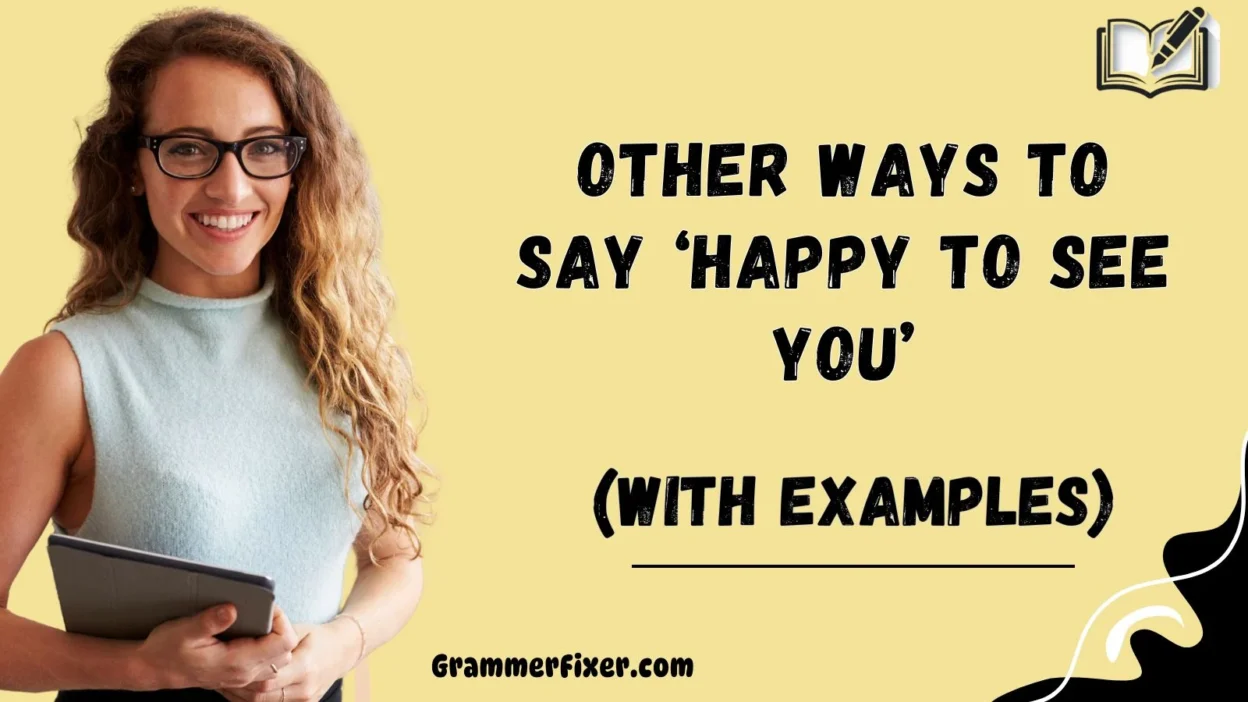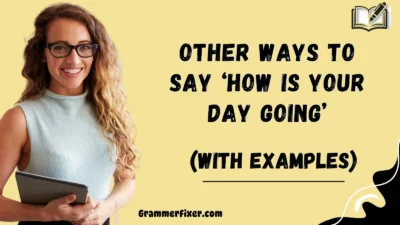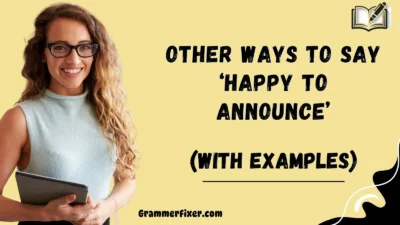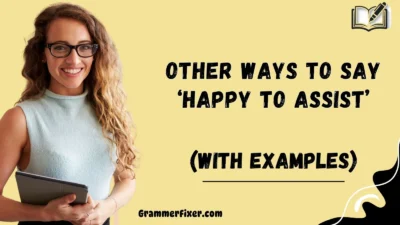Finding the right words to express joy when greeting someone can make even ordinary interactions feel more meaningful. While “Happy to See You” is a warm and friendly phrase, sometimes you might want to add more variety, tone, or personal touch depending on whether you’re meeting a friend, a colleague, or a family member.
In this article, we’ll explore 30 thoughtful alternatives to “Happy to See You,” so you can strengthen your connections with words that feel both authentic and heartfelt.
What Does “Happy to See You” Mean?
At its core, “Happy to See You” is a common greeting used to express joy, gratitude, and affection upon encountering someone. It communicates positive emotions, conveys a sense of care, and shows that the person’s presence brightens your mood.
When to Use “Happy to See You”?
You can use this phrase in casual, professional, and social contexts—such as when meeting a friend after a long time, greeting a colleague at work, or welcoming a family member at home. It works especially well in reunions or when you want to highlight that someone’s presence matters to you.
Is It Professional/Polite to Say “Happy to See You”?
Yes. The phrase is both professional and polite, provided the tone is genuine and the setting appropriate. In a workplace, you may want to use slightly more formal expressions like “Pleased to See You” or “It’s a Pleasure to Meet You.” In casual encounters, the original phrase works perfectly.
Pros or Cons
Pros:
- Warm and versatile across different settings.
- Builds rapport and fosters positive relationships.
- Simple, clear, and universally understood.
Cons:
- May feel overused or generic if repeated often.
- In some formal environments, it may sound too casual.
1. Glad to See You
Meaning: Expresses joy and friendliness.
Explanation: A simple yet heartfelt way to show appreciation for someone’s presence.
Example: “I’m so glad to see you after all this time!”
Best Use: Casual meetings with friends or family.
Worst Use: In a strictly formal business introduction where a more polished phrase like “Pleased to meet you” is expected.
Tone: Warm, genuine, cheerful.
2. Great Seeing You
Meaning: Signals delight in an encounter.
Explanation: Works well for casual farewells or quick catch-ups.
Example: “It was great seeing you at the café today.”
Best Use: Short interactions or social gatherings.
Worst Use: During a first meeting with someone important (e.g., a senior executive or client).
Tone: Friendly, upbeat.
3. What a Pleasant Surprise
Meaning: Conveys unexpected joy.
Explanation: Ideal when you didn’t expect to see the person.
Example: “Oh wow, what a pleasant surprise to run into you here!”
Best Use: Unplanned encounters.
Worst Use: When the meeting was scheduled or planned—it may sound insincere.
Tone: Playful, appreciative.
4. Nice to See You Again
Meaning: Emphasizes joy in reconnecting.
Explanation: Good for people you’ve met before but not recently.
Example: “It’s so nice to see you again after all these months.”
Best Use: Reunions, reconnecting with colleagues.
Worst Use: When meeting someone for the first time, as “again” creates confusion.
Tone: Warm, respectful.
5. Always a Pleasure
Meaning: Reflects genuine appreciation.
Explanation: Suggests every meeting with this person is enjoyable.
Example: “Always a pleasure to see you, Maria.”
Best Use: Polite greetings in both social and professional settings.
Worst Use: If the relationship is tense or strained—it can sound forced or sarcastic.
Tone: Polished, gracious, thoughtful.
6. Delighted to See You
Meaning: A more formal and refined way to express happiness.
Explanation: Often used in professional or socially polished settings, it adds a touch of charm and sophistication.
Example: “I’m truly delighted to see you at the reception tonight.”
Best Use: Work functions, networking events, formal gatherings.
Worst Use: Casual settings with close friends—it may sound too stiff or distant.
Tone: Polite, refined, gracious.
7. It’s Been Too Long
Meaning: Expresses warmth and acknowledgment of time apart.
Explanation: Suggests that the reunion is overdue and highlights the value of reconnecting.
Example: “It’s been too long since we last caught up!”
Best Use: Friends, relatives, old colleagues you haven’t seen in a while.
Worst Use: In a professional setting with someone you only vaguely know—it may feel overly personal.
Tone: Nostalgic, affectionate, genuine.
8. Thrilled to See You
Meaning: Shows heightened excitement and enthusiasm.
Explanation: Stronger than “glad,” it conveys deep happiness and eagerness.
Example: “I’m absolutely thrilled to see you here today!”
Best Use: Close friends, loved ones, celebratory reunions.
Worst Use: Formal introductions or serious settings where neutral language is preferred.
Tone: Energetic, enthusiastic, joyful.
9. Pleased to See You
Meaning: A polite and professional version of the greeting.
Explanation: Suitable for neutral or businesslike environments without losing warmth.
Example: “I’m very pleased to see you again at the conference.”
Best Use: Workplace interactions, polite greetings with acquaintances.
Worst Use: Very intimate or casual moments—it may feel too detached.
Tone: Courteous, respectful, professional.
10. Wonderful to See You
Meaning: Expresses genuine happiness in a heartfelt way.
Explanation: Conveys sincerity and emphasizes the specialness of the encounter.
Example: “It’s truly wonderful to see you again, Sarah.”
Best Use: Friends, family, heartfelt reunions.
Worst Use: Overly formal business meetings—it might sound too emotional.
Tone: Sincere, warm, affectionate.
11. Overjoyed to See You
Meaning: Highlights deep elation at someone’s presence.
Explanation: Stronger than “happy,” suggesting immense happiness or relief.
Example: “I’m overjoyed to see you safe and sound.”
Best Use: Emotional reunions, especially after long absences.
Worst Use: Quick greetings in casual or professional contexts—it feels over the top.
Tone: Deeply emotional, affectionate, heartfelt.
12. Ecstatic to See You
Meaning: Extreme happiness and excitement.
Explanation: Conveys a vibrant, heightened level of joy.
Example: “I’m ecstatic to see you back in town!”
Best Use: Celebratory reunions with close friends or family.
Worst Use: In professional or serious situations—it may come across as unprofessional.
Tone: Exuberant, joyful, lively.
13. So Happy to See You
Meaning: Reinforces warmth with extra emphasis.
Explanation: Simple, heartfelt, and suitable across many contexts.
Example: “I’m so happy to see you today—it made my morning brighter.”
Best Use: Everyday greetings with friends, family, colleagues.
Worst Use: In very formal introductions, where “pleased” or “delighted” fits better.
Tone: Warm, friendly, approachable.
14. Fantastic to See You
Meaning: Adds enthusiasm and positivity.
Explanation: Expresses genuine joy with a slightly more energetic flair.
Example: “It’s fantastic to see you here after so long!”
Best Use: Friendly catch-ups, casual work settings, joyful reunions.
Worst Use: Serious occasions like condolence visits—the tone would feel inappropriate.
Tone: Cheerful, enthusiastic, upbeat.
15. Elated to See You
Meaning: Strong but polished expression of joy.
Explanation: Slightly more formal than “thrilled,” often signaling deep satisfaction.
Example: “I’m elated to see you succeeding in your new role.”
Best Use: Supportive encounters, reunions, and professional compliments.
Worst Use: Everyday casual greetings—it may sound too grandiose.
Tone: Positive, refined, heartfelt.
16. Excited to See You
Meaning: Expresses eagerness and anticipation.
Explanation: Conveys both happiness and energy, making the meeting feel important.
Example: “I’m so excited to see you at the event tonight!”
Best Use: Friends, family, or casual professional contexts where enthusiasm is welcome.
Worst Use: Very serious or solemn situations, where excitement might seem inappropriate.
Tone: Energetic, cheerful, welcoming.
17. Pleased to Meet You
Meaning: A formal and respectful greeting for new introductions.
Explanation: Shows courtesy and warmth without being overly casual.
Example: “It’s a pleasure to meet you, Mr. Khan.”
Best Use: Business introductions, formal events, networking.
Worst Use: With close friends or relatives, where it would feel distant or stiff.
Tone: Professional, polite, neutral.
18. It’s a Pleasure to See You
Meaning: Combines politeness with warmth.
Explanation: Slightly more refined than “happy to see you,” often used in both personal and professional contexts.
Example: “It’s always a pleasure to see you at these gatherings.”
Best Use: Work settings, polite friendships, acquaintances.
Worst Use: Very casual hangouts with friends where it might sound over-formal.
Tone: Courteous, respectful, gracious.
19. Immensely Gratified by Your Presence
Meaning: Extremely formal way of saying someone’s presence is appreciated.
Explanation: Conveys deep gratitude and high regard for the other person.
Example: “I’m immensely gratified by your presence at this ceremony.”
Best Use: Ceremonial events, speeches, formal acknowledgments.
Worst Use: Everyday casual greetings—it will sound exaggerated or pretentious.
Tone: Formal, respectful, elevated.
20. Good to See You Back
Meaning: Highlights happiness at someone’s return.
Explanation: Useful when greeting someone after an absence or break.
Example: “Good to see you back in the office!”
Best Use: Workplace returns, family gatherings, school reunions.
Worst Use: With people you’ve never met before—it may sound confusing.
Tone: Friendly, welcoming, supportive.
21. Great to Have You Here
Meaning: Expresses appreciation for someone’s presence.
Explanation: Works well in both personal and professional gatherings.
Example: “It’s great to have you here for the meeting today.”
Best Use: Hosting events, work functions, family dinners.
Worst Use: Random encounters on the street—it feels contextually forced.
Tone: Welcoming, inclusive, appreciative.
22. Wonderful Running Into You
Meaning: Highlights joy in a chance encounter.
Explanation: Suggests spontaneity and delight when unexpectedly seeing someone.
Example: “It was wonderful running into you downtown today!”
Best Use: Casual, unplanned meetings with friends or acquaintances.
Worst Use: Formal settings or planned events—it loses authenticity.
Tone: Spontaneous, cheerful, light.
23. Delighted We Crossed Paths
Meaning: Polished way to describe a pleasant, perhaps serendipitous meeting.
Explanation: Can be used for both personal and professional encounters.
Example: “I’m delighted we crossed paths at the seminar.”
Best Use: Networking events, social occasions, chance meetings.
Worst Use: Very casual daily settings where it may sound too scripted.
Tone: Refined, warm, professional.
24. Lucky to See You Today
Meaning: Expresses joy while suggesting that the meeting feels special.
Explanation: Adds an element of serendipity to the greeting.
Example: “I feel lucky to see you here—it made my day brighter.”
Best Use: Friendly reunions, casual social interactions.
Worst Use: Formal contexts, where “lucky” may feel too casual or overly personal.
Tone: Playful, sincere, lighthearted.
25. What a Treat to See You
Meaning: Shows delight, as if the meeting is a rare gift.
Explanation: Suggests the encounter feels special and uplifting.
Example: “What a treat to see you here at the party!”
Best Use: Friends, family, warm social circles.
Worst Use: In business introductions, where it may come across as unprofessional.
Tone: Joyful, affectionate, playful.
26. You’ve Made My Day
Meaning: Expresses how much the encounter means emotionally.
Explanation: Highlights the positive impact of someone’s presence.
Example: “Seeing you today has truly made my day!”
Best Use: Close friends, family, emotional reunions.
Worst Use: Strictly professional interactions, as it may sound overly personal.
Tone: Heartfelt, grateful, affectionate.
27. Can’t Believe We’re Meeting Again
Meaning: Shows surprise and happiness about reconnecting.
Explanation: Acknowledges that the meeting feels both unexpected and special.
Example: “I can’t believe we’re meeting again after all these years!”
Best Use: Reunions with old friends, acquaintances, or distant relatives.
Worst Use: In professional introductions, where disbelief can feel informal.
Tone: Surprised, emotional, enthusiastic.
28. Always Brings Me Joy to See You
Meaning: Emphasizes how consistently valuable the person’s presence is.
Explanation: Communicates affection and appreciation across repeated meetings.
Example: “It always brings me joy to see you, Aunt Maria.”
Best Use: Close relationships, family, warm friendships.
Worst Use: Formal or brief meetings—it may feel too sentimental.
Tone: Affectionate, heartfelt, sincere.
29. I’ve Missed Seeing You
Meaning: Acknowledges absence and emotional value of reunion.
Explanation: Signals that the person was thought of and valued during time apart.
Example: “I’ve missed seeing you—it’s been too long!”
Best Use: Reconnecting after months or years with friends or relatives.
Worst Use: With casual acquaintances or professional contacts—it may feel too intimate.
Tone: Nostalgic, affectionate, sincere.
30. My Heart Leaps to See You
Meaning: A poetic and deeply emotional way to express happiness.
Explanation: Conveys profound affection, often reserved for close loved ones.
Example: “My heart leaps to see you every time you walk into the room.”
Best Use: Romantic relationships, close family, very dear friends.
Worst Use: In professional or casual contexts—it may feel overly dramatic.
Tone: Romantic, poetic, emotional.
Conclusion
Saying “Happy to See You” is a universal way to express joy, but sometimes we want words that feel fresh, meaningful, and tailored to the situation. These 30 alternatives give you a wide range of casual, formal, warm, and poetic options, so you can choose what best matches your tone, relationship, and context.



